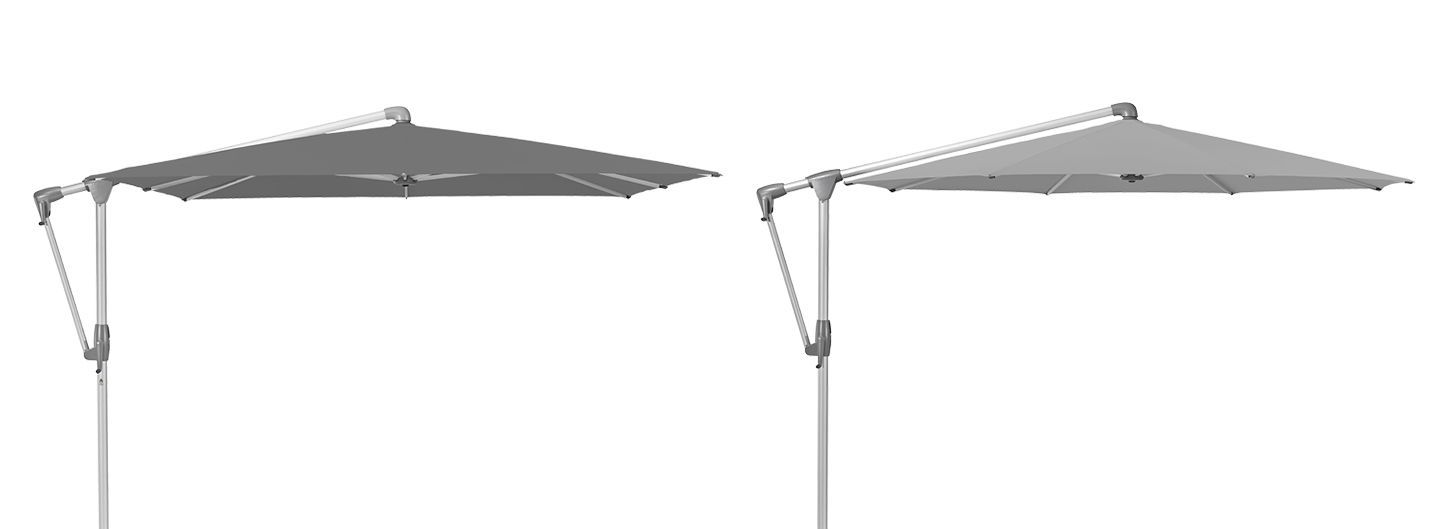- Garden parasols
- Contract parasols
- Good to know
- Inspirations
Design your Glatz parasol
Parasol configuratorDesign your Glatz parasol
Parasol configuratorHere are the 13 most important points to keep in mind when buying a parasol. By observing them, you can be sure of finding the right shading solution for your needs, so that you can enjoy your parasol for many years to come. You can then easily put together your Glatz parasol in our configurator.
Basically, a parasol consists of:
a fixation;
a mast with a crown;
a parasol roof made of fabric
First of all, the right basic parasol model should be found, with the mast type influencing the choice of fixation and parasol roof (size, shape, fabric quality and colour).
We recommend that you consider the following questions before choosing your parasol model:
How large is the area to be shaded?
This will help you choose the right parasol size.
Is my garden more round or rectangular?
The answer to this question will help you choose the shape of the parasol roof (round, square or rectangular). Ideally, the shape of the garden should be reflected in the shape of the parasol and thus reflect the architecture.

Which colour suits my garden and the architectural context?
With some models, the frame is available in different basic shades (natural anodised, powder-coated, anthracite, wood or white). Our recommendation: take your cue from the colour of the window frames so that the parasol blends in well with the overall architectural look.

What do I want to shade – a table, lounge, sunlounger? For tables and lounges, a side-mast parasol is the ideal choice because it works without a central mast, thereby providing plenty of shade. For sunloungers, in contrast, a centre-pole parasol is optimal, as it fits perfectly between two loungers.

Which direction is my shaded area facing? Where is south? Answering these questions is important, because the parasol is usually positioned precisely where shading is to be provided.
What is the nature of the ground? Determining the nature of the ground will provide you with valuable information regarding fixation options: Is it a lawn? If so, we recommend using a lawn spike or ground fixation. Is the ground solid, tiled or concrete? If so, a base or – if the parasol is to be moved around – a roller base is the best choice. Here is an overview of our fixation options. Keep in mind that not every parasol model is suitable for every fixation type. Once you have selected the basic model, the configurator will show you the appropriate fixations for the respective parasol.

Do you have sun in the evening?
If so, we recommend a side-mast parasol (also called a cantilever parasol) that can be conveniently tilted when the sun is low.
Do you want to be able to continuously adjust the parasol to the position of the sun?
If so, a side-mast parasol is a very good choice, as it can be swivelled 360 degrees around the mast. Or does the sun always come from the same side and is the parasol always used at the same time of day?
Will my parasol be placed in a wind-exposed location?
If so, then choose a wind-stable centre-pole or side-mast parasol from our F range. These parasol types are also ideal for roof terraces.
Will the parasol also be used as a privacy screen (e.g. against passers-by or neighbours)?
If so, a side-mast parasol is a suitable choice, because it allows the roof to be easily fixed at an angle. The most flexible parasol, which even allows vertical alignment, is the Pendalex P+ model.
Which colour(s) do I prefer for the canopy? Which colour matches my outdoor furniture and my home?
Here is a complete overview of our fabric colours and quality levels. Generally speaking, the higher the fabric quality, the less susceptible it is to fading and the higher its water repellence and robustness. Glatz lists three fabric qualities (2, 4 and 5) that differ in terms of their characteristics. All three have a good basic quality and UV protection of >98%, which corresponds to a sun protection factor of 50+. It should be noted that a parasol can only protect from direct sunlight. UV rays, however, also reflect from the ground, from building walls and from water surfaces.

What about parasol lighting for cosy evenings?
A number of our parasols have integrated LED lighting. In addition, we also offer our practical and variable LED spotlights. These can be attached to almost any parasol model.

Do I have a suitable protective cover for my parasol?
The right protective cover protects against dirt, prevents fading of the fabric and ensures greater longevity and enjoyment of your high-quality Glatz parasol.
Exposure to sunlight (UV radiation), weather conditions (wind, rain, snow) and the duration/frequency of use affect the service life of the protective cover, therefore it must be replaced regularly. Storing the parasol and protective cover in a sheltered/dry place over winter further increases their service life.

Tip: Make a sketch with measurements, possibly also with a photo of your patio, balcony or garden, mark where south is and take your sketch together with your individual parasol configurator result to your specialist dealer. You can find a list of trusted, authorised Glatz dealers located near you here. We provide regular training to our specialist dealers. With their expert knowledge, they will help you choose the right parasol for you for delivery from our parasol factory in Eastern Switzerland.